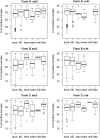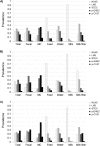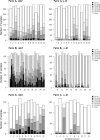Dynamics of Escherichia coli Virulence Factors in Dairy Herds and Farm Environments in a Longitudinal Study in the United States
- PMID: 25911478
- PMCID: PMC4475889
- DOI: 10.1128/AEM.00465-15
Dynamics of Escherichia coli Virulence Factors in Dairy Herds and Farm Environments in a Longitudinal Study in the United States
Abstract
Pathogenic Escherichia coli or its associated virulence factors have been frequently detected in dairy cow manure, milk, and dairy farm environments. However, it is unclear what the long-term dynamics of E. coli virulence factors are and which farm compartments act as reservoirs. This study assessed the occurrence and dynamics of four E. coli virulence factors (eae, stx1, stx2, and the gamma allele of the tir gene [γ-tir]) on three U.S. dairy farms. Fecal, manure, water, feed, milk, and milk filter samples were collected from 2004 to 2012. Virulence factors were measured by postenrichment quantitative PCR (qPCR). All factors were detected in most compartments on all farms. Fecal and manure samples showed the highest prevalence, up to 53% for stx and 21% for γ-tir in fecal samples and up to 84% for stx and 44% for γ-tir in manure. Prevalence was low in milk (up to 1.9% for stx and 0.7% for γ-tir). However, 35% of milk filters were positive for stx and 20% were positive for γ-tir. All factors were detected in feed and water. Factor prevalence and levels, expressed as qPCR cycle threshold categories, fluctuated significantly over time, with no clear seasonal signal independent from year-to-year variability. Levels were correlated between fecal and manure samples, and in some cases autocorrelated, but not between manure and milk filters. Shiga toxins were nearly ubiquitous, and 10 to 18% of the lactating cows were potential shedders of E. coli O157 at least once during their time in the herds. E. coli virulence factors appear to persist in many areas of the farms and therefore contribute to transmission dynamics.
Copyright © 2015, American Society for Microbiology. All Rights Reserved.
Figures



Similar articles
-
Comparison of Escherichia coli Isolates from humans, food, and farm and companion animals for presence of Shiga toxin-producing E. coli virulence markers.Foodborne Pathog Dis. 2004 Fall;1(3):178-84. doi: 10.1089/fpd.2004.1.178. Foodborne Pathog Dis. 2004. PMID: 15992278
-
Incidence of Escherichia coli O157:H7 and E. coli virulence factors in US bulk tank milk as determined by polymerase chain reaction.J Dairy Sci. 2007 Jul;90(7):3212-9. doi: 10.3168/jds.2006-009. J Dairy Sci. 2007. PMID: 17582104
-
Detection of Shiga toxin (Stx)-producing Escherichia coli (STEC) in bovine dairy herds in Northern Italy.Int J Food Microbiol. 2014 Aug 1;184:45-9. doi: 10.1016/j.ijfoodmicro.2013.12.033. Epub 2014 Jan 10. Int J Food Microbiol. 2014. PMID: 24495690
-
Escherichia coli O157:H7 and non-O157 Shiga toxin-producing E. coli in healthy cattle, sheep and swine herds in Northern Spain.Zoonoses Public Health. 2008;55(2):73-81. doi: 10.1111/j.1863-2378.2007.01080.x. Zoonoses Public Health. 2008. PMID: 18234025
-
Evolution of virulence in opportunistic pathogens: generalism, plasticity, and control.Trends Microbiol. 2012 Jul;20(7):336-42. doi: 10.1016/j.tim.2012.04.005. Epub 2012 May 5. Trends Microbiol. 2012. PMID: 22564248 Free PMC article. Review.
Cited by
-
Multidrug-Resistant Enteropathogenic Escherichia coli Isolated from Diarrhoeic Calves, Milk, and Workers in Dairy Farms: A Potential Public Health Risk.Antibiotics (Basel). 2022 Jul 25;11(8):999. doi: 10.3390/antibiotics11080999. Antibiotics (Basel). 2022. PMID: 35892389 Free PMC article.
-
Prevalence, Antimicrobial Susceptibility, and Molecular Characterization of Escherichia coli Isolated From Raw Milk in Dairy Herds in Northern China.Front Microbiol. 2021 Sep 24;12:730656. doi: 10.3389/fmicb.2021.730656. eCollection 2021. Front Microbiol. 2021. PMID: 34630355 Free PMC article.
-
Characteristics of Pathogenic Escherichia coli Associated with Diarrhea in Children under Five Years in Northwestern Ethiopia.Trop Med Infect Dis. 2024 Mar 21;9(3):65. doi: 10.3390/tropicalmed9030065. Trop Med Infect Dis. 2024. PMID: 38535888 Free PMC article.
-
Prevalence, antimicrobial resistance, and genotyping of Shiga toxin-producing Escherichia coli in foods of cattle origin, diarrheic cattle, and diarrheic humans in Egypt.Gut Pathog. 2021 Feb 5;13(1):8. doi: 10.1186/s13099-021-00402-y. Gut Pathog. 2021. PMID: 33546735 Free PMC article.
-
Climate, lactation, and treatment factors influence faecal shedding of Escherichia coli O157 pathotypes in dairy cows.Epidemiol Infect. 2017 Jan;145(1):115-125. doi: 10.1017/S0950268816001928. Epub 2016 Sep 16. Epidemiol Infect. 2017. PMID: 27634484 Free PMC article.
References
-
- Farrokh C, Jordan K, Auvray F, Glass K, Oppegaard H, Raynaud S, Thevenot D, Condron R, De Reu K, Govaris A, Heggum K, Heyndrickx M, Hummerjohann J, Lindsay D, Miszczycha S, Moussiegt S, Verstraete K, Cerf O. 2013. Review of Shiga-toxin-producing Escherichia coli (STEC) and their significance in dairy production. Int J Food Microbiol 162:190–212. doi:10.1016/j.ijfoodmicro.2012.08.008. - DOI - PubMed
-
- Carneiro LAM, Lins MC, Garcia FRA, Silva APS, Mauller PM, Alves GB, Rosa ACP, Andrade JRC, Freitas-Almeida AC, Queiroz MLP. 2006. Phenotypic and genotypic characterisation of Escherichia coli strains serogrouped as enteropathogenic E. coli (EPEC) isolated from pasteurised milk. Int J Food Microbiol 108:15–21. doi:10.1016/j.ijfoodmicro.2005.10.010. - DOI - PubMed
MeSH terms
Substances
LinkOut - more resources
Full Text Sources
Medical

